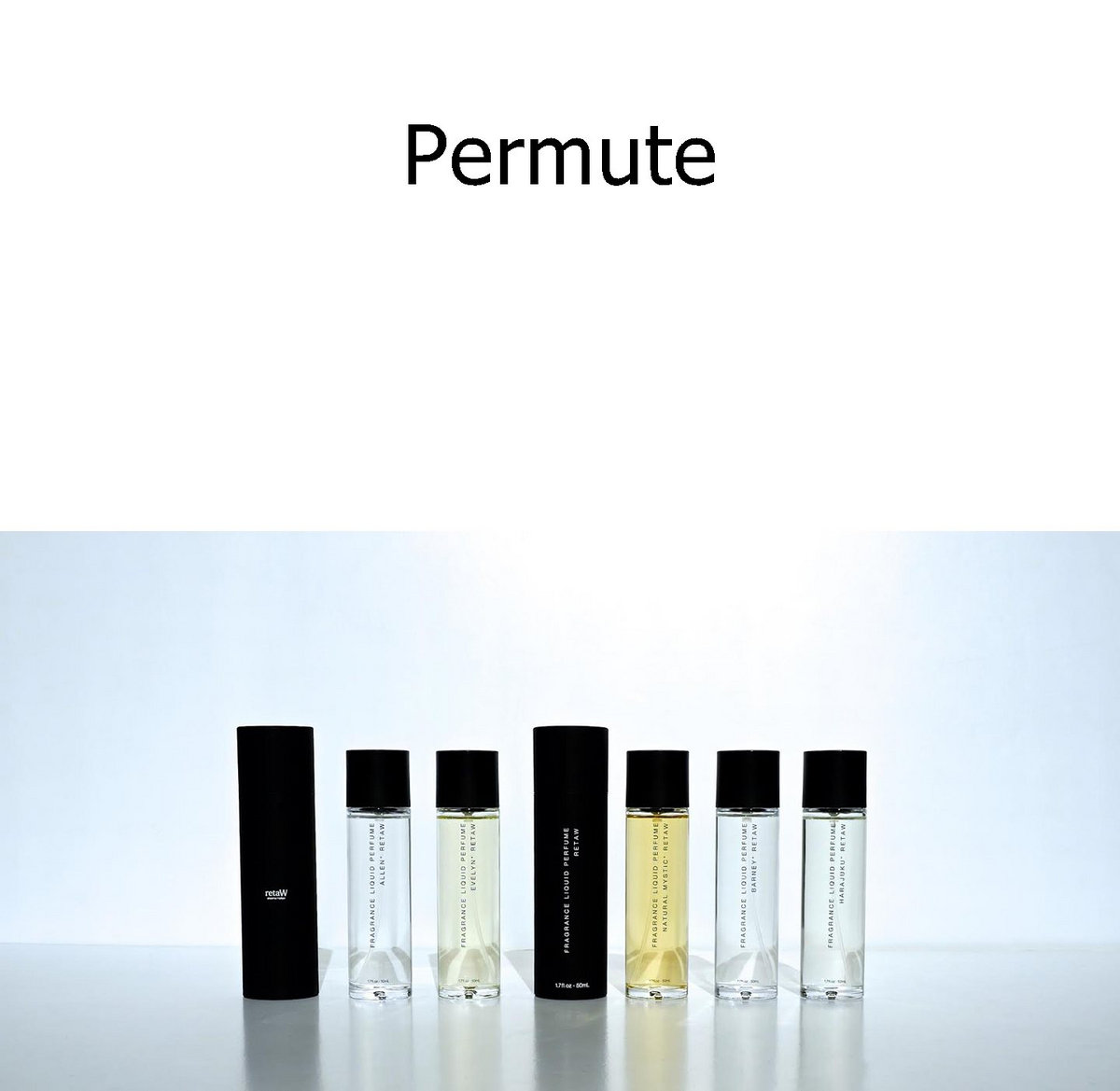Julia has support for sparse vectors and sparse matrices in the SparseArrays stdlib module. Sparse arrays are arrays that contain enough zeros that storing them in a special data structure leads to savings in space and execution time, compared to dense arrays.
- Download Permute 3 for macOS 10.12 or later and enjoy it on your Mac. Permute is a versatile tool that allows you to convert video, audio and images files into different formats, increase volume, merge them and much more!
- Permute is the easiest to use media converter with it's easy to use, no configuration, drag and drop interface, it will meet the needs to convert all. MAC Permute 3.1.2 macOS - ITA Permute: il convertitore di video semplice, funzionale e personalizzabile.
A permutation, also called an “arrangement number” or “order,” is a rearrangement of the elements of an ordered list S into a one-to-one correspondence with S itself. The number of permutations of n distinct objects, taken r at a time is: n P r = n! = (7) (6) (5) = 210 Thus, 210 different 3-digit numbers can be formed from the digits 1, 2, 3. Permute 3 is a superb application that empowers you to converts your media files to various different formats without sacrificing the quality. It has excellent ability to fulfill the needs of various users related to media conversion.
In Julia, sparse matrices are stored in the Compressed Sparse Column (CSC) format. Julia sparse matrices have the type SparseMatrixCSC{Tv,Ti}, where Tv is the type of the stored values, and Ti is the integer type for storing column pointers and row indices. The internal representation of SparseMatrixCSC is as follows:
The compressed sparse column storage makes it easy and quick to access the elements in the column of a sparse matrix, whereas accessing the sparse matrix by rows is considerably slower. Operations such as insertion of previously unstored entries one at a time in the CSC structure tend to be slow. This is because all elements of the sparse matrix that are beyond the point of insertion have to be moved one place over.
All operations on sparse matrices are carefully implemented to exploit the CSC data structure for performance, and to avoid expensive operations.

If you have data in CSC format from a different application or library, and wish to import it in Julia, make sure that you use 1-based indexing. The row indices in every column need to be sorted. If your SparseMatrixCSC object contains unsorted row indices, one quick way to sort them is by doing a double transpose.
In some applications, it is convenient to store explicit zero values in a SparseMatrixCSC. These are accepted by functions in Base (but there is no guarantee that they will be preserved in mutating operations). Such explicitly stored zeros are treated as structural nonzeros by many routines. The nnz function returns the number of elements explicitly stored in the sparse data structure, including non-structural zeros. In order to count the exact number of numerical nonzeros, use count(!iszero, x), which inspects every stored element of a sparse matrix. dropzeros, and the in-place dropzeros!, can be used to remove stored zeros from the sparse matrix.
Sparse vectors are stored in a close analog to compressed sparse column format for sparse matrices. In Julia, sparse vectors have the type SparseVector{Tv,Ti} where Tv is the type of the stored values and Ti the integer type for the indices. The internal representation is as follows:
As for SparseMatrixCSC, the SparseVector type can also contain explicitly stored zeros. (See Sparse Matrix Storage.).
The simplest way to create a sparse array is to use a function equivalent to the zeros function that Julia provides for working with dense arrays. To produce a sparse array instead, you can use the same name with an sp prefix:
The sparse function is often a handy way to construct sparse arrays. For example, to construct a sparse matrix we can input a vector I of row indices, a vector J of column indices, and a vector V of stored values (this is also known as the COO (coordinate) format). sparse(I,J,V) then constructs a sparse matrix such that S[I[k], J[k]] = V[k]. The equivalent sparse vector constructor is sparsevec, which takes the (row) index vector I and the vector V with the stored values and constructs a sparse vector R such that R[I[k]] = V[k].
The inverse of the sparse and sparsevec functions is findnz, which retrieves the inputs used to create the sparse array. findall(!iszero, x) returns the cartesian indices of non-zero entries in x (including stored entries equal to zero).
Another way to create a sparse array is to convert a dense array into a sparse array using the sparse function:
You can go in the other direction using the Array constructor. The issparse function can be used to query if a matrix is sparse.
Arithmetic operations on sparse matrices also work as they do on dense matrices. Indexing of, assignment into, and concatenation of sparse matrices work in the same way as dense matrices. Indexing operations, especially assignment, are expensive, when carried out one element at a time. In many cases it may be better to convert the sparse matrix into (I,J,V) format using findnz, manipulate the values or the structure in the dense vectors (I,J,V), and then reconstruct the sparse matrix.
The following table gives a correspondence between built-in methods on sparse matrices and their corresponding methods on dense matrix types. In general, methods that generate sparse matrices differ from their dense counterparts in that the resulting matrix follows the same sparsity pattern as a given sparse matrix S, or that the resulting sparse matrix has density d, i.e. each matrix element has a probability d of being non-zero.
Details can be found in the Sparse Vectors and Matrices section of the standard library reference.

| Sparse | Dense | Description |
|---|---|---|
spzeros(m,n) | zeros(m,n) | Creates a m-by-n matrix of zeros. (spzeros(m,n) is empty.) |
sparse(I,n,n) | Matrix(I,n,n) | Creates a n-by-n identity matrix. |
sparse(A) | Array(S) | Interconverts between dense and sparse formats. |
sprand(m,n,d) | rand(m,n) | Creates a m-by-n random matrix (of density d) with iid non-zero elements distributed uniformly on the half-open interval $[0, 1)$. |
sprandn(m,n,d) | randn(m,n) | Creates a m-by-n random matrix (of density d) with iid non-zero elements distributed according to the standard normal (Gaussian) distribution. |
sprandn(rng,m,n,d) | randn(rng,m,n) | Creates a m-by-n random matrix (of density d) with iid non-zero elements generated with the rng random number generator |
Supertype for N-dimensional sparse arrays (or array-like types) with elements of type Tv and index type Ti. SparseMatrixCSC, SparseVector and SuiteSparse.CHOLMOD.Sparse are subtypes of this.
Calculator Use
Like the Combinations Calculator the Permutations Calculator finds the number of subsets that can be taken from a larger set. However, the order of the subset matters. The Permutations Calculator finds the number of subsets that can be created including subsets of the same items in different orders.
- Factorial
- There are n! ways of arranging n distinct objects into an ordered sequence, permutations where n = r.
- Combination
- The number of ways to choose a sample of r elements from a set of n distinct objects where order does not matter and replacements are not allowed.
- Permutation
- The number of ways to choose a sample of r elements from a set of n distinct objects where order does matter and replacements are not allowed. When n = r this reduces to n!, a simple factorial of n.
- Combination Replacement
- The number of ways to choose a sample of r elements from a set of n distinct objects where order does not matter and replacements are allowed.
- Permutation Replacement
- The number of ways to choose a sample of r elements from a set of n distinct objects where order does matter and replacements are allowed.
- n
- the set or population
- r
- subset of n or sample set
Permutations Formula:
For n ≥ r ≥ 0.
Calculate the permutations for P(n,r) = n! / (n - r)!. 'The number of ways of obtaining an ordered subset of r elements from a set of n elements.'[1]
Permutation Problem 1
Choose 3 horses from group of 4 horses
In a race of 15 horses you beleive that you know the best 4 horses and that 3 of them will finish in the top spots: win, place and show (1st, 2nd and 3rd). So out of that set of 4 horses you want to pick the subset of 3 winners and the order in which they finish. How many different permutations are there for the top 3 from the 4 best horses?
For this problem we are looking for an ordered subset of 3 horses (r) from the set of 4 best horses (n). We are ignoring the other 11 horses in this race of 15 because they do not apply to our problem. We must calculate P(4,3) in order to find the total number of possible outcomes for the top 3 winners.
P(4,3) = 4! / (4 - 3)! = 24 Possible Race Results
If our 4 top horses have the numbers 1, 2, 3 and 4 our 24 potential permutations for the winning 3 are {1,2,3}, {1,3,2}, {1,2,4}, {1,4,2}, {1,3,4}, {1,4,3}, {2,1,3}, {2,3,1}, {2,1,4}, {2,4,1}, {2,3,4}, {2,4,3}, {3,1,2}, {3,2,1}, {3,1,4}, {3,4,1}, {3,2,4}, {3,4,2}, {4,1,2}, {4,2,1}, {4,1,3}, {4,3,1}, {4,2,3}, {4,3,2}
Permutation Problem 2

Choose 3 contestants from group of 12 contestants
Evaluate 9p3
At a high school track meet the 400 meter race has 12 contestants. The top 3 will receive points for their team. How many different permutations are there for the top 3 from the 12 contestants?
For this problem we are looking for an ordered subset 3 contestants (r) from the 12 contestants (n). We must calculate P(12,3) in order to find the total number of possible outcomes for the top 3.
Permute 3.4
P(12,3) = 12! / (12-3)! = 1,320 Possible Outcomes
Permutation Problem 3
Choose 5 players from a set of 10 players
An NFL team has the 6th pick in the draft, meaning there are 5 other teams drafting before them. If the team believes that there are only 10 players that have a chance of being chosen in the top 5, how many different orders could the top 5 be chosen?

For this problem we are finding an ordered subset of 5 players (r) from the set of 10 players (n).
P(10,5)=10!/(10-5)!= 30,240 Possible Orders
References

[1] For more information on permutations and combinations please see Wolfram MathWorld: Permutation.
